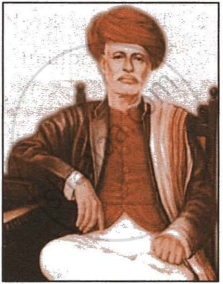Advertisements
Advertisements
Question
Picture Study.

- Identify the person in the given picture. Name the organisation formed by him. State any two beliefs of this organisation with regard to the upliftment of women.
- Mention his contribution to the growth of the Indian National movement.
- How did the socio-religious reform movements of the 19th century act as pioneers of Indian Nationalism?
Solution
- The person in the image is Jyotiba Phule. In 1873, he established the Satya Shodhak Samaj. This organisation held two principles regarding women's empowerment:
- Jyotiba Phule and his organisation believed that women were superior to males and intended to educate them in order to perpetuate this belief.
- Jyotiba Phule and his organisation pioneered the widow remarriage movement in Maharashtra and established a private orphanage for widows.
- Jyotiba Phule made the following contributions to the expansion of the Indian National Movement:
- He advocated for the empowerment of women. To equip them with an education, he and his wife Savitribai Phule established one of Pune's earliest female schools.
- He pioneered widow remarriage and established a special orphanage for widows.
- He saw the caste system present in India as the essence of enslavement. He described the hardships and suffering felt by the lower castes in his classic work, 'Ghulamgiri'.
- In 1873, he established the Satya Shodhak Samaj with the goal of ensuring social justice for the poorest members of society.
- The socio-religious reform movements of the nineteenth century were significant pioneers of Indian nationalism in the following ways:
- The impact of.Western education, which resulted in a rational, humane, and scientific perspective on life, made educated Indians understand the importance of reforming their religion and society.
- The reformers criticised untouchability and the caste system. The notions of fraternity and equality appealed to the so-called lower castes.
- The reformers educated people not to underestimate the value of women who could engage in the national movement.
- In the social realm, these groups advocated for the eradication of the caste system, child marriage, dowry, purdah, sati, and infanticide.
- In the theological realm, these reform movements challenged religious superstitions and condemned idolatry, polytheism, and hereditary priesthood.
- The reform movements raised awareness of a new society free of advantages based on caste, creed, or religion.
- They revolted against British dominance in India. Swami Dayanand Saraswati and Swami Vivekananda asserted the superiority of Indian culture and civilisation. Swami Dayanand Saraswati was the first to introduce the term 'Swaraj' and promote the slogan 'India for the Indians'.
APPEARS IN
RELATED QUESTIONS
Tahir is preparing to give a speech about the Sati system in India. Which of the following Indian leader's contributions MUST he mention in his speech?
Your school has organized a poster making competition on the topic - Education empowerment for Girls in India. Which of the following leaders would MOST LIKELY be part of the poster?
Which of the following was/were the beliefs of the Brahma Samaj with respect to religion?
- Belief in Monotheism
- Emphasis on rituals and prayers
- Emphasis on prayer, meditation and charity
- Emphasis on unity between people of all religions and creeds
How did the socio-religious reform movements of the 19th century act as pioneers of lndian Nationalism?
- They proclaimed the superiority of Indian culture and civilisation.
- They believed that British rule in India would lead to a society based on equality and equanimity.
- They created a consciousness of a new society devoid of privileges based on caste, creed or religion.
State any two issues that the socio-religious reform movements worked for.
Name any two socio-religious reformers who prepared the ground for national movement.
Write a short note on Raja Rammohan Roy's approach to religion.
Name the organisation founded by Raja Rammohan Roy.
Why did Raja Rammohan Roy establish the Brahma Samaj organisation?
Imagine you are a member of Brahma Samaj. Elaborate what convinced you to join the Brahma Samaj and how are you influenced by Raja Rammohan Roy.
